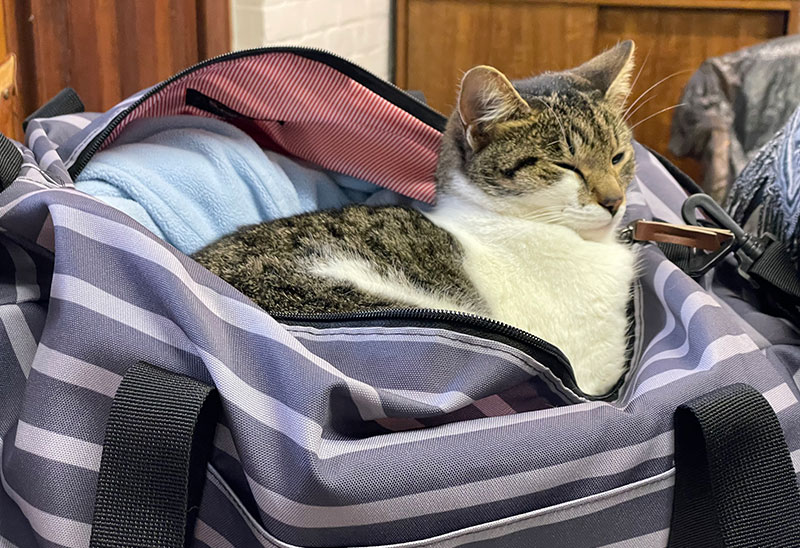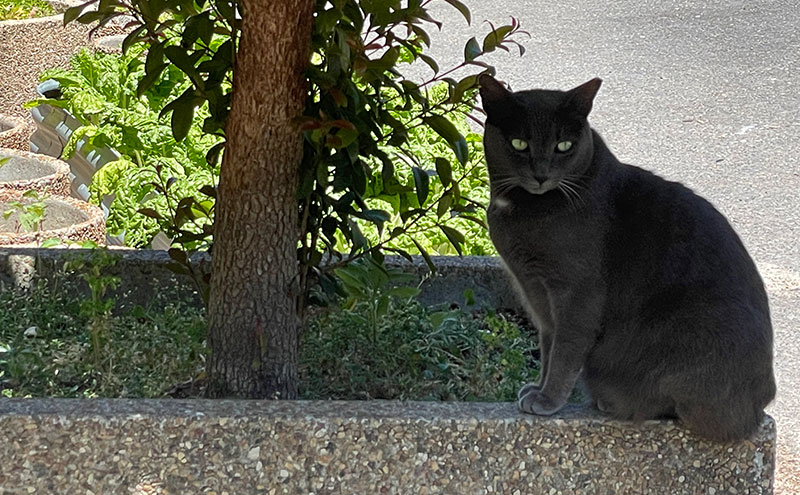How to manage UCT’s semi-feral cats ethically and responsibly
10 November 2023 | Story Helen Swingler. Photos Supplied. Voice Cwenga Koyana. Read time 9 min.
A discussion document published by the University of Cape Town’s (UCT) Institute for Communities and Wildlife in Africa (iCWild) lists six policy proposals to manage the semi-feral cats on the main campus abutting the Table Mountain National Park (TMNP).
A recent survey of wildlife on UCT’s upper campus revealed that Cape genet, Cape grysbok, Cape porcupine, caracal, and water mongoose are frequent visitors, but that the most common animal is the domestic cat. With easy access to the TMNP across a porous boundary, these feral feline predators may pose a threat to rodents and birds. There is also a risk of feral cats passing on Feline Immunodeficiency Virus (FIV) to caracals.
The discussion document, “Liminal Animals in a Liminal Space: Semi-feral cats on Cape Town’s urban edge”, is a case study co-authored by Professor Nicoli Nattrass, Dr Zoë Woodgate and Professor Justin O’Riain. Professors Nattrass and O’Riain are the principal investigators of the campus wildlife research, one of five Khusela Ikamva (“secure our future”) Sustainable Campus projects.
The R10 million five-year-long (2021–2026), campus-wide project supports the environmental sustainability aspects of UCT’s Vision 2030. The other four focus on UCT’s energy/carbon footprint, water, waste, and social responsiveness.
Ethics and responsibilities
The discussion document explores ethical and ecologically responsible ways of managing the feral cat population in a way that is consistent with conserving wildlife. The proposals range from creating an animal barrier between upper campus and TMNP, to creating an enclosed cattery where the cats can be cared for, protected from road traffic and inoculated, particularly against FIV.
There are pros and cons to all six options, also linked to the many and often competing views of cats as pampered ‘fur children’, rodent exterminators; community cats; predators of engendered wildlife; or nuisance feral felines.
“How we should understand and manage the ecological and social role of cats is a complex problem.”
As the authors wrote, “Biological conservationists at UCT typically understand the semi-feral cats as out-of-place invasive animals (even as many are empathetic to them). But for those who feed and care for the cats, they are individuals deserving of our respect and care.” They argue that there is an inevitable ‘cosmopolitics’ involved in balancing UCT’s concern for feral cats (and what it means for them to live an acceptable life) with the rights and obligations to wildlife UCT has given its position on the urban edge.
“The challenge, in every context,” said the authors, “is to elucidate the trade-offs and principles at stake – both from an animal rights and ecological perspective.”
Nattrass added: “We are hoping to spark a wider discussion about how best to manage UCT’s cats from an animal welfare and nature conservation perspective.”
Trap, neuter, euthanise – or live and let live?
Many of UCT’s upper campus feral cat population (the health sciences campus and Hiddingh campuses also have feral cat populations) are too wild to be rehomed as domestic pets. Management methods have varied over the years and now currently focus on trapping, neutering and releasing them (TNR).
But TNR, while preventing breeding and the spread of disease, is not a magic bullet for animal welfare, said Nattrass. Neutered feral cats live “additionally liminal lives as neither functionally wild nor domestically cared for animals”. They are not vaccinated and are thus exposed to disease and can potentially transmit diseases to wildlife.
According to cat carers on upper campus, the number of cared-for cats has been “small and fluctuating” since the 1990s.

In an earlier wildlife case study in 2022, 20 cats were found to be living on upper campus; some born there, others strayed into UCT or were possibly dumped there. Some are fully feral, leading independent lives, others are relatively tame and have forged close relationships with their carers.
Since 2012, the upper campus semi-feral cats have been cared for in two colonies: one at the UCT nursery, cared for by the senior horticulturalist; and the other near the New Engineering Building, cared for by a senior librarian.
According to the proposal document, over the years kittens have been caught and adopted by various concerned parties. But many of the named and cared-for cats have been killed by cars, become ill (and have had to be euthanised), or simply disappeared (possibly captured and eaten by caracal).
Some of the cats may have been killed after eating rats poisoned by rodenticides. Such secondary poisoning of wild predators by rat poison is a significant threat to wild predators on the city’s urban edge. UCT is trying to move away from such poisons, but they remain in use in areas where food waste continues to attract rodents. Dealing with waste is thus an important priority for protecting wildlife on UCT’s urban edge.
Looking for solutions to the challenge posed by feral cats
The policy options proposed by the authors are:
- Keep the status quo. This means continuing to rely on TNR with the help of volunteers, and the efforts of individual cat carers. Cats will no longer reproduce, but the population could grow as new cats arrive. New ‘intact’ cats could push the neutered cats (especially males) out of their territory. Another downside is that the cats will remain unvaccinated and it will be difficult to provide sufficient healthcare for the cats – they could transmit diseases to each other and to other wild animals.
- Sterilise the cats rather than neuter them. Some cat carers favour sterilisation rather than neutering to keep them hormonally intact, but unable to reproduce. This, however, means more cat fights (and injuries) and nuisance behaviour such as spraying and yowling. Cats will probably be less friendly (and not valued as much as neutered community cats), be more exposed to sexually transmitted diseases, and will likely lead shorter lives.
- Remove cats from the campus by taking them to a sanctuary or euthanising them. This has benefits for wildlife but will be traumatic for the cats and their caregivers. It is also likely to be a short-term solution as other cats will find their way onto campus.
- Remove new cats from the campus, by either taking them to a sanctuary or euthanising them. The population of cats will be stable but decline as the cats die off.
- Create animal barriers between upper campus and the national park. There are initial capital costs involved and maintenance of the fence will be necessary.
- Create a large cat enclosure or cattery to protect wildlife on campus and in the national park. The cats can more easily be vaccinated, treated for disease, provisioned and petted.
Regarding euthanising the cats, the authors accept that this is unlikely to gain broad support – not only because of the evolved close relationship between humans and animals, but because of shifts towards compassionate conservation more generally.

For Nattrass, it is essential for UCT to come up with a locally relevant, considered policy that is inclusive of all people concerned – and which is “based on careful consideration of the welfare of all the animals involved”. The UCT case is also relevant for the management of cats on urban edges globally, she said.
But more – and ongoing – research is needed, Nattrass concluded.
 This work is licensed under a Creative Commons Attribution-NoDerivatives 4.0 International License.
This work is licensed under a Creative Commons Attribution-NoDerivatives 4.0 International License.
Please view the republishing articles page for more information.
Listen to the news
The stories in this selection include an audio recording for your listening convenience.











































































































































































































































































































































































































